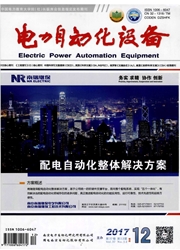

 中文摘要:
中文摘要:
基于离散混成自动机(DHA)理论,提出混成自动发电控制(HAGC)的概念、原理以及体系结构。HAGC体系结构由混成模型、实际系统和系统数据3部分组成。混成模型由切换电力系统(SPS)、事件产生器(EG)、有限状态机(FSM)和模式选择器(MS)4个模块组成;论述了混成模型的4个模块,给出了示意图。HAGC控制器的设计采用3层结构(最高决策层、中间操作层、底层执行层);对事件的判断与生成、操作指令的形成、HAGC算法及优化进行了讨论。上海电网的成功投运,证明了HAGC能在保证系统安全性的同时提高系统的经济性指标,实现了多目标优化控制。
 英文摘要:
英文摘要:
Based on DHA (Discrete Hybrid Automation) theory, the concept, principle and structure of HAGC(Hybrid Automatic Generation Control) are proposed. HAGC is composed of three parts: hybrid model,physical system and systern data. The hybrid model of HAGC consists of four modules: SPS(Switch Power System), EG(Event Generator),FSM(Finite State Machine) and MS(Mode Selector). These modules are explicated with sketch maps. The controller of HAGC is based on three-layer structure(decision-making, operation and execution). The detection and generation of events, the formation of operation order and the algorithm and optimization of HAGC are discussed. Its successful operation in Shanghai power grid verifies that HAGC improves economy while ensures security,and achieves the goal of multiple-objective semioptimization control.
 同期刊论文项目
同期刊论文项目
 同项目期刊论文
同项目期刊论文
 New research advancement in electrical engineering field of China-Reviews on special issue of Scienc
New research advancement in electrical engineering field of China-Reviews on special issue of Scienc Speed regulation of permanent magnet synchronous motor via feedback dissipative Hamiltonian realizat
Speed regulation of permanent magnet synchronous motor via feedback dissipative Hamiltonian realizat 期刊信息
期刊信息
